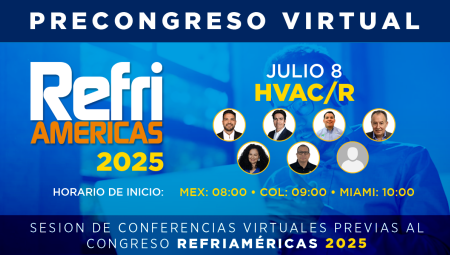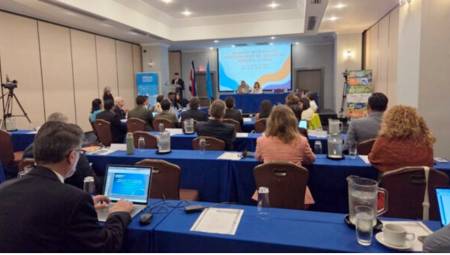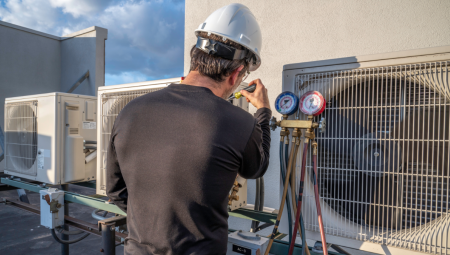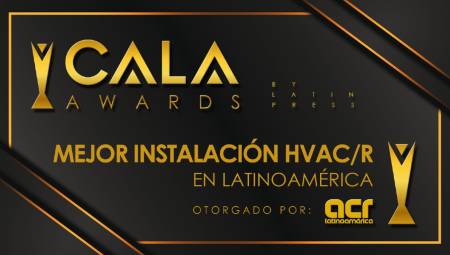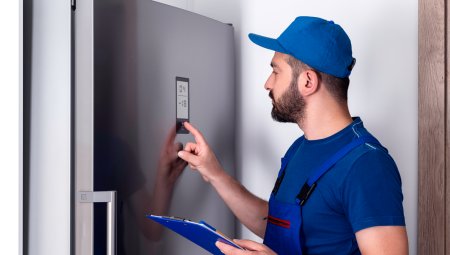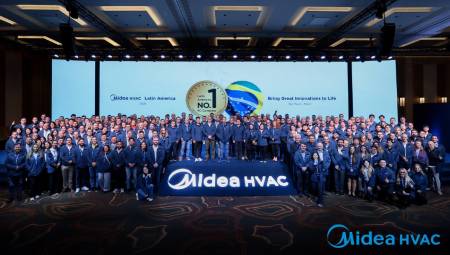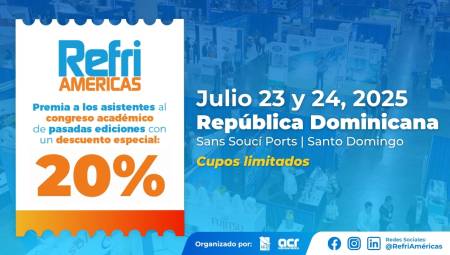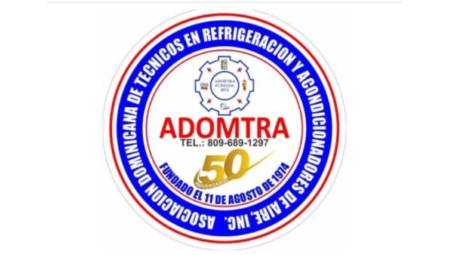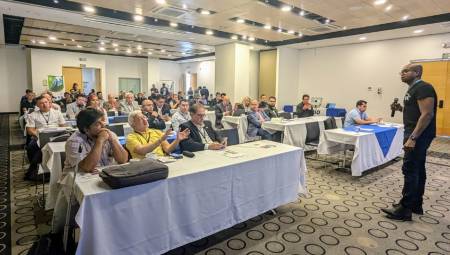By: Héctor Gómez Pérez
 As good schoolchildren, several Latin American countries have been carrying out various actions aimed at complying with the Montreal Treaty as far as the issue of refrigerants harmful to the environment is concerned. It could be said that less than a year before the deadline for the 100% reduction of Cluroflurocarbon refrigerants (CFCs) is met, many countries are winning the year and have done the task applied.
As good schoolchildren, several Latin American countries have been carrying out various actions aimed at complying with the Montreal Treaty as far as the issue of refrigerants harmful to the environment is concerned. It could be said that less than a year before the deadline for the 100% reduction of Cluroflurocarbon refrigerants (CFCs) is met, many countries are winning the year and have done the task applied.
We consulted a group of experts representing four countries in the region: Brazil, Chile, Colombia and Mexico to present their point of view on this issue and share their countries' experiences in terms of environmental commitment.
Brazil meets in part
On behalf of Brazil, the guest was Jorge Colaço, management advisor of Recigases Ambiental de Refrigeración de Sao Paulo. As commented by this expert, the main action of the Brazilian government in the matter has been the prohibition of manufacture and import of CFCs, in addition to these refrigerants not being used in recent manufacturing equipment.
In that sense, he assures that there is a partial government commitment by saying that "in the area of import and manufacture of this type of refrigerants there is a real commitment, but the real action would be to implement collection and recycling and that is not working." For him, the main problem of state policies is the neglect of recycling issues, since the release of refrigerant gases into the environment is extremely harmful, but in his opinion there are many economic interests involved to prevent this from continuing to happen.
Regarding the training in these topics for the technicians of the industry, he says that although there is a program that seeks to train them and that even gives them a gas recycling equipment at the end of the course, the best proof that it is not working is that much of the equipment is still without owners. Another aspect that he considers inconvenient is that in his view the customs and port personnel are not equipped to check the refrigerants that enter the country.
Colaço is emphatic in pointing out that there are two situations that in his country go against each other: environmental protection and economic interests. "In addition to the protection of the environment, the most important thing would be the economic issue, since recycling these substances represents a great saving for everyone, except for gas manufacturers," he said.
For this professional, the reports that Brazil delivers this year to the Secretariat of the Multilateral Fund on the consumption of ODS's (ozone-depleting substances) will say that the country is complying with the deadlines agreed in the Montreal Protocol, only that these reports forget that nothing is being done in terms of recycling. "The good part of the Protocol is that the change of the type of gas used in the industry has been well implemented. This part is the one that most interests all gas manufacturers. The part that really interests the environment which is the collection and recycling is a great failure," he emphasized.
Colombia is on the right track
In Colombia, this issue is handled by the Ozone Technical Unit (UTO), an entity attached to the Ministry of Environment, Housing and Territorial Development. Jorge E. Sánchez, national coordinator of the UTO accepted the invitation of ACR LATINOAMÉRICA.
According to Sánchez, the commitments made by Colombia in the signing of the Montreal Protocol and its amendments have been 100% fulfilled, and he highlighted as some of the main achievements in the matter the elimination of the use of CFCs in the manufacture of domestic and commercial refrigerators, through technical assistance projects to manufacturing companies; reduction of CFC imports by 85% (until December 2007). He also said that "currently the only use of CFCs is in the maintenance of old refrigeration and air conditioning equipment."
Precisely this governmental commitment made Colombia and the UTO were awarded at the XIX meeting of the Parties in Montreal in 2007, as one of the countries with the greatest commitment in the implementation of the Protocol.
On the issue of HCFCs, this country, like all Latin Americans that are classified as Article 5, and therefore have a broader elimination schedule than developed countries, is entering the control stage since the baseline will be the country's consumption in the years 2009 and 2010; the 100% reduction for this type of refrigerant is contemplated by 2040.
For the general coordinator of the UTO, the main obstacle that has been found in this path for the elimination of ODS has been the lack of training of technicians in maintenance of air conditioning and refrigeration, an issue that has been solved with the UTO-SENA alliance (National Learning Service) with the training and certification project.
"To date, the UTO database has detailed information on approximately 8,000 workers who offer maintenance services for domestic, commercial and industrial refrigeration equipment and systems," Sánchez said. Of this number, 70% are empirical, 25% have received formal training and the remaining 5% have a university professional degree.
Currently, SENA offers the service of free Vocational Training for this sector, in the maintenance of refrigeration and air conditioning equipment with curricular programs that include the "Good Practices in Refrigeration".
Regarding the customs issue, Sánchez said that since 2003 it has been working in coordination with the DIAN (Directorate of National Customs) to control the trade in substances that deplete the environment. Between 2003 and 2006, a training project for customs officials was carried out, consisting of a workshop for trainers and trainers, 9 workshops for 315 customs employees, 80 environmental employees and 11 Venezuelan officials.
To this is added the delivery of refrigerant analyzer equipment to the customs of Cúcuta, Buenaventura, Ipiales, Barranquilla, Riohacha, Medellín, Eldorado Airport, Santa Marta, Cartagena, Bogotá, Cali and Customs Technical Subdirectorate – Central Level Laboratory.
Chile has encouraging figures
In Chile we have the collaboration of Álvaro Sapag Rajevic, executive director of the National Environmental Commission of Chile (CONAMA). As far as the southern country is concerned, the Country Programme for environmental protection has been implemented since 1993; this program is responsible for channeling the resources granted by the Multilateral Fund for the Implementation of the Montreal Protocol, and currently executes projects for the elimination of CFCs in the foams, refrigeration, technical services and solvents sectors.
Sapag stressed that the Chilean government has always had the industry as an ally and said that "this is how the large and medium-sized refrigeration and foam companies that used CFCs in their production processes, were reconverted thanks to the support they received a few years ago in projects such as TECFIN I and II implemented by the Ozone Unit of CONAMA."
On the other hand, the Refrigerant Management Plan has focused on supporting technical and maintenance services in refrigeration and air conditioning, through free training and delivery of equipment for the recovery and recycling of refrigerant gases. In this sense, the implementation of a certification system in labor skills that will allow greater control of refrigeration technicians becomes important.
The figures are on the side of Chile: during 2008 it was reduced to 47.89 tons weighted by the potential for depletion of the ozone layer (ton ODP), being the maximum consumption of 124.3 ton ODP, which started from a baseline of 828.7 ton ODP (average of the years 1995-1997).
In Chile, as in other countries in the region, the main drawback to the substitution of refrigerants harmful to the environment has been the ignorance of the subject by users and the lack of awareness of this environmental problem. This situation has been solved through awareness campaigns aimed at refrigeration and air conditioning technicians, as well as large users and students.
"This task has involved a great effort of the technicians themselves who after years of working in a way, have learned to apply new methodologies and use new equipment that allows them to manipulate in an environmentally appropriate way the exhausting gases of the ozone layer and alternative gases," said Sapag. This has resulted in the implementation between 2003 and 2006 of 78 free training courses in Good Refrigeration Practices for 1700 technicians throughout 13 cities in the country; In addition, these practices are already part of the curricula of the educational institutions of technical and professional careers of refrigeration and air conditioning in the country.
A very innovative project in Chile is the exhibition at the Mirador Interactive Museum, in Santiago, of an interactive sample of the process of destruction of the ozone layer by the effect of ODS's. In 2008 458,058 people visited the museum.
Mexico, an applied country
Ana María Contreras Vigil, general director of Air Quality Management and Pollutant Emissions and Transfer Registry (PRTR) of Semarnat (Ministry of the Environment and Natural Resources), participated in talking about the situation in Mexico, who highlighted the following as the main actions of the Mexican government against the Montreal Protocol and the replacement of refrigerants:
- In September 2005, the production of CFCs was closed in this country, which had an impact on 60% of the production of these substances in america and 12% worldwide. With the closure of cfc production in Mexico, the commitment to the Protocol was advanced by four years.
- Currently in Mexico no CFCs are produced and only about 50 tons of them are consumed in pharmaceutical grade to produce metered-dose inhalers for people with asthma.
- To raise awareness among technicians in the refrigeration and air conditioning sectors about the environmental damages that are generated by releasing refrigerants into the atmosphere (ozone layer and global warming), the infrastructure was created to train them in the application of "Good Practices in Refrigeration and Air Conditioning Systems", to detect and repair refrigerant leaks (CFC, HCFC and HFC), recovery, recycling and replacement of refrigerants that do not affect the ozone layer. Currently the course is taught in 22 schools to which the equipment and training of 110 of their teachers were provided, who in turn have transferred their knowledge to more than 5000 technicians.
- 2100 sets of equipment were acquired to be donated to the outstanding trained technicians, so that they apply good practices and avoid the emission of refrigerant gases that damage the ozone layer and / or are the cause of global warming. 1250 pieces of equipment have been delivered and delivery will continue until the 2100 are completed.
- Customs personnel from SAT-SHCP and PROFEPA were trained to detect and prevent illicit cfC trafficking. Likewise, the 20 main customs offices of the country through which the import and export of ODS are carried out and the Central Customs Laboratory were equipped.
- Studies are under way to define the National Plan for the Elimination of HCFC Hydrochlorofluorocarbons in accordance with the timetable established by the Montreal Protocol.
"The Government of Mexico and the industry have demonstrated with actions their commitment to eliminate refrigerants that deplete the ozone layer and has met the goals established in the Montreal Protocol to eliminate these substances," said Contreras and added that the Aztec country is one of the most active members of said protocol, among other things for being the first nation in which an ozone protection unit operated.


